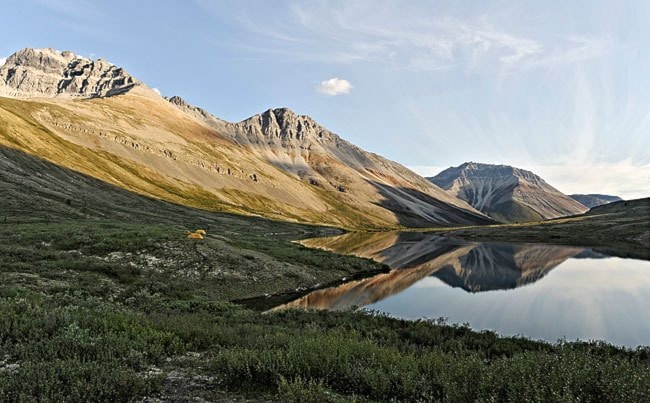Yukon First Nations and environmental groups are asking the Supreme Court of Canada to hear the case over the Peel River watershed.
Their lawyer, chiefs from three First Nations, along with representatives from the Canadian Parks and Wilderness Society and the Yukon Conservation Society made the announcement Tuesday.
Last month the Yukon Court of Appeal ruled “Yukon undermined reconciliation by failing to honour the letter and spirit of its treaty obligations” when it released its plan for the 68,000 square kilometres of mostly undisturbed Yukon wilderness.
That plan was dramatically different from the 80 per cent protection recommended by the Peel land use planning commission. It protected only 29 per cent from new mineral staking.
While much of the public attention around the case has been focused on the environmental protection of the area, the Peel case focuses on the rules for planning laid out in Yukon’s Umbrella Final agreement with First Nations.
Both the original Yukon Supreme Court Justice Ron Veale and the appeal judges agreed the Yukon government failed to live up to its end of the bargain when its plan came out.
But the two courts don’t agree on when the mistake happened and what should be done to make up for it.
Veale’s original ruling put some restrictions on the government. He said it could go back and make some changes to the recommended 80 per cent protection, but these changes could not alter balance between protection and development, or allow building new roads or other surface access into the area.
Veale said the government didn’t provide enough detail about the changes it wanted earlier in the process, so those points were off the table.
The Court of Appeal rolled things back even further, saying the government could make any changes it wanted so long as it properly consulted with everyone and provided a more detailed explanation of what it wanted to do.
It’s that remedy that the First Nations and environmental groups are appealing.
“This ability for a do-over works to the great advantage of the government and the great disadvantage of First Nations, Yukoners and the process contemplated under the final agreements,” said their lawyer, Margaret Rosling.
“Such an approach to interpreting land use planning agreements would mean it would be open to either party to say they want to restart the process and dial the clock back to an earlier stage.
“There would be no certainty or predictability in the land use planning process. There would be little motivation for First Nations and Yukoners to bother participating if at the end of the day the government would have the untrammelled ability to roll the matter back to the earlier stage.”
The groups have until early January to file their application but say they expect to have it done by Christmas.
“We’re willing to take this stand not only for the Peel but to ensure certainly for all future planning processes in the Yukon,” said Roberta Joseph, chief of the Tr’ondek Hwech’in First Nation.
Only about 10 per cent of the cases that apply to the top court are heard. When applying to be heard, lawyers have to convince the court their case is worthwhile because the issues it raises are nationally significant.
In the case of the Peel, the interpretation of the Umbrella Final Agreement has that kind of national significance, according to Rosling. It’s an example of a modern treaty between non-aboriginal governments and aboriginal people, she said.
“It’s the interpretation of those treaties and that dialogue that has the application throughout Canada.”
According to the most recent statistics, it usually takes about three to four months for the Supreme Court to decide if it will hear a case. Judges don’t provide reasons, just a simple yes or no. It then typically takes another eight or nine months before a hearing.
Arguing a case in front of the Supreme Court of Canada is not cheap.
So far the First Nations and environmental groups have refused to say how much they have spend on the case up to this point.
Chief Simon Mervyn of the Nacho Nyak Dun said the First Nations were willing to cover the cost alone, if it came to that.
“But with the help of our outside interest groups we appreciate that everybody is sharing the costs,” he said.
Premier Darrell Pasloski said he is disappointed that the First Nations and environmental groups have decided to go this route.
“I don’t think this is a necessary step. The Court of Appeal really did provide clarity around the process that is described in the Umbrella Final Agreement,” he said.
“And it reaffirmed that democratically-elected public governments have final say on public land, which also means that on settlement land the First Nation should have final say on First Nation land as well.”
In a statement the Yukon government said it “remains open to finding an out-of-court agreement, as it has through all phases of the process.”
But the plaintiffs say the Court of Appeal decision needs to be challenged, even if there is a change of government after the next territorial election, which must be held by the autumn of 2016.
“It’s the highest court of Yukon and if we aren’t permitted to appeal to the Supreme Court of Canada, that decision will stand and it will guild land use planning processes in the Yukon,” Rosling said.
“That’s why we believe that this case has to be brought forward, not only in the interest of the land use planning process for the Peel watershed but also for land use planning processes in Yukon under the final agreements.”
Once the application for leave to appeal is filed with the Supreme Court of Canada the Yukon government will have 30 days to respond.
Contact Ashley Joannou at
ashleyj@yukon-news.com
